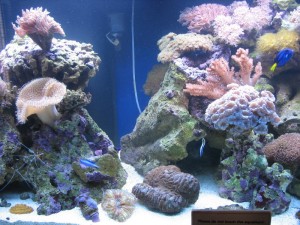A saltwater aquarium is harder to maintain than a freshwater aquarium because it contains certain elements that are not usually found in ordinary water conditions. Likewise, it also needs a stricter monitoring of water quality in order for the marine creatures to survive. Some of the important aspects to consider when maintaining this kind of aquarium include the lighting, heating as well as the filtration system. Be able to enjoy the presence of beautiful marine creatures inside your home by learning how to maintain a saltwater aquarium.
Materials Needed
Maintaining a marine aquarium is quite easy. For this task, you only need a couple of materials, namely siphon and de-chlorinated water. Once you have these, you can start enjoying a nice clean aquarium at home.
Steps
It is very important to check the aquarium on a daily basis. This can actually help you determine whether some fishes are about to die or are already dead. Just stand next to the aquarium and then observe the movements of the fishes for several minutes. By doing this regularly, you can become more familiar with the normal behavior of the fishes. With that, it is easier to identify the sick ones from the healthy ones.
In terms of food, feeding the fishes every three days is sufficient to keep them strong and healthy. However, varying their diet is important so that they can enjoy different kinds of vitamins and nutrients. Pour de-chlorinated water on the evaporated water. After this, it is good to add calcium in order to make the fishes healthier. At least two times a week, be sure to add iodine to the water to make it conducive and livable for the fishes.
Remove the algae from the tank by scraping the walls of the aquarium for at least once a week. Aside from this, make it a habit to take out 10 to 15 percent of the water from the tank. Replace it with fresh de-chlorinated water. By doing this, the unwanted chemicals can somehow be diluted. If this is done regularly, fewer problems can be experienced. While changing the water, use the siphon to remove debris and dirt from the gravel.
A day after changing the water, it is important to test the elements available in the water including the copper, pH levels as well as calcium. Do the same thing for the nitrate, nitrite and ammonia, all of which are important for invertebrates. In addition, do not forget to check the filter pads at least twice a month. When necessary, try to replace or clean them at least. The alkalinity of the water must also be checked on a monthly basis.



